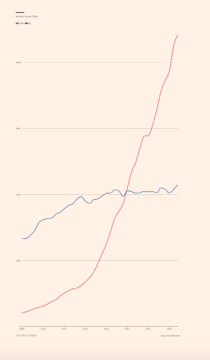Rachel Kleinfeld at Persuasion:
 Last week, a widely-circulated analysis in the Financial Times confirmed what many researchers had long suspected: The ideological gap between men and women is growing.
Last week, a widely-circulated analysis in the Financial Times confirmed what many researchers had long suspected: The ideological gap between men and women is growing.
Over the past fifteen years, men across the globe have voted for radical right-wing parties at much higher rates. Spain’s far-right, populist, and conspiracy-minded Vox party polls roughly twice as well among men compared with women. While men and women voted for Poland’s anti-democratic Law and Justice Party at similar rates last year, men voted for the even more extreme Konfederacja nearly three times as much as women. Data from a 2009 study of European parties that leaned authoritarian or populist found that men were generally around twice as likely as women to vote for them—and up to five times more likely in the case of the nationalist-populist Swedish Democrats.
It’s not just Europe: Brazil’s Jair Bolsonaro performed 10 points better among men than women in the 2018 election which brought him to power. Roughly the same gender difference pushed Argentina’s new populist libertarian leader, Javier Milei, over the top last November.
In some countries, gender aligns very closely with other social or demographic variables like class, education, and employment—but in a number of places, being male makes a big difference, independent of other factors.
The United States is no exception.
More here.

 Neuralink was founded in 2016 by
Neuralink was founded in 2016 by  As data from the IEA confirm, the scale of China’s green energy push in the last couple of years dwarfs the much ballyhooed green energy programs in the West – NextGenEU, IRA etc.
As data from the IEA confirm, the scale of China’s green energy push in the last couple of years dwarfs the much ballyhooed green energy programs in the West – NextGenEU, IRA etc. There was a brief period in the later part of the Covid-19 pandemic, between the moment when Glenn Youngkin swept into the Virginia governorship and the full political return of Donald Trump, when I became convinced that American liberalism was headed for a truly epochal defeat in 2024.
There was a brief period in the later part of the Covid-19 pandemic, between the moment when Glenn Youngkin swept into the Virginia governorship and the full political return of Donald Trump, when I became convinced that American liberalism was headed for a truly epochal defeat in 2024. M
M I
I Back in 2001, immunologist Pere Santamaria was exploring a new way to study diabetes. Working in mice, he and his collaborators developed a method that uses iron oxide nanoparticles to track the key immune cells involved in the disorder.
Back in 2001, immunologist Pere Santamaria was exploring a new way to study diabetes. Working in mice, he and his collaborators developed a method that uses iron oxide nanoparticles to track the key immune cells involved in the disorder. We hypothesize that fictional stories are highly successful in human cultures partly because they activate evolved cognitive mechanisms, for instance for finding mates (e.g., in romance fiction), exploring the world (e.g., in adventure and speculative fiction), or avoiding predators (e.g., in horror fiction). In this paper, we put forward a comprehensive framework to study fiction through this evolutionary lens.The primary goal of this framework is to carve fictional stories at their cognitive joints using an evolutionary framework. Reviewing a wide range of adaptive variations in human psychology–in personality and developmental psychology, behavioral ecology, and evolutionary biology, among other disciplines –, this framework also addresses the question of interindividual differences in preferences for different features in fictional stories. It generates a wide range of predictions about the patterns of combinations of such features, according to the patterns of variations in the mechanisms triggered by fictional stories. As a result of a highly collaborative effort, we present a comprehensive review of evolved cognitive mechanisms that fictional stories activate.To generate this review, we (1) listed more than 70 adaptive challenges humans faced in the course of their evolution, (2) identified the adaptive psychological mechanisms that evolved in response to such challenges, (3) specified four sources of adaptive variability for the sensitivity of each mechanism(i.e., personality traits, sex, age, and ecological conditions), and (4) linked these mechanisms to the story features that trigger them. This comprehensive framework lays the ground for a theory-driven research program for the study of fictional stories, their content, distribution, structure, and cultural evolution.
We hypothesize that fictional stories are highly successful in human cultures partly because they activate evolved cognitive mechanisms, for instance for finding mates (e.g., in romance fiction), exploring the world (e.g., in adventure and speculative fiction), or avoiding predators (e.g., in horror fiction). In this paper, we put forward a comprehensive framework to study fiction through this evolutionary lens.The primary goal of this framework is to carve fictional stories at their cognitive joints using an evolutionary framework. Reviewing a wide range of adaptive variations in human psychology–in personality and developmental psychology, behavioral ecology, and evolutionary biology, among other disciplines –, this framework also addresses the question of interindividual differences in preferences for different features in fictional stories. It generates a wide range of predictions about the patterns of combinations of such features, according to the patterns of variations in the mechanisms triggered by fictional stories. As a result of a highly collaborative effort, we present a comprehensive review of evolved cognitive mechanisms that fictional stories activate.To generate this review, we (1) listed more than 70 adaptive challenges humans faced in the course of their evolution, (2) identified the adaptive psychological mechanisms that evolved in response to such challenges, (3) specified four sources of adaptive variability for the sensitivity of each mechanism(i.e., personality traits, sex, age, and ecological conditions), and (4) linked these mechanisms to the story features that trigger them. This comprehensive framework lays the ground for a theory-driven research program for the study of fictional stories, their content, distribution, structure, and cultural evolution. Some of the largest and most notable prediction markets to date have been around elections. The only problem? Prediction markets simply aren’t very good at political predictions. Markets for major U.S. elections are some of the deepest prediction markets anywhere: billions of dollars bet, millions of daily trades, and huge amounts of press. In theory, the larger the market, the more accurate the predictions. But in the markets with the biggest spotlight, we see a lot of strange stuff. Predictions that don’t line up with common sense. Odds that seem to defy reality. Obviously noncredible market movements. To figure out why, we’ll have to explore the underlying mechanisms that make markets work, and why the typical user of political prediction markets may not behave in the ways we expect.
Some of the largest and most notable prediction markets to date have been around elections. The only problem? Prediction markets simply aren’t very good at political predictions. Markets for major U.S. elections are some of the deepest prediction markets anywhere: billions of dollars bet, millions of daily trades, and huge amounts of press. In theory, the larger the market, the more accurate the predictions. But in the markets with the biggest spotlight, we see a lot of strange stuff. Predictions that don’t line up with common sense. Odds that seem to defy reality. Obviously noncredible market movements. To figure out why, we’ll have to explore the underlying mechanisms that make markets work, and why the typical user of political prediction markets may not behave in the ways we expect. Coming upon an Andre as you turn a corner in a gallery can be a lovely surprise. But for all the smaller controversies it has generated, it has become almost impossible to look down at Andre’s bricks, to tread his floors of metal plates, or gaze at his constructions of cut ash and cedar timbers, without thinking of the death of the
Coming upon an Andre as you turn a corner in a gallery can be a lovely surprise. But for all the smaller controversies it has generated, it has become almost impossible to look down at Andre’s bricks, to tread his floors of metal plates, or gaze at his constructions of cut ash and cedar timbers, without thinking of the death of the  The biggest recent find in classical music was the discovery that in 1940, Sergei Rachmaninoff was privately recorded by the conductor Eugene Ormandy. Seated at Ormandy’s piano, he played through his new Symphonic Dances, which Ormandy would soon premiere with the Philadelphia Orchestra. Singularly, Rachmaninoff never permitted his public performances to be broadcast—so this surreptitious home recording is the best evidence we have of what Rachmaninoff’s legendary pianism sounded like outside the confines of recording studios sucked clean of the oxygen a body of listeners can activate.
The biggest recent find in classical music was the discovery that in 1940, Sergei Rachmaninoff was privately recorded by the conductor Eugene Ormandy. Seated at Ormandy’s piano, he played through his new Symphonic Dances, which Ormandy would soon premiere with the Philadelphia Orchestra. Singularly, Rachmaninoff never permitted his public performances to be broadcast—so this surreptitious home recording is the best evidence we have of what Rachmaninoff’s legendary pianism sounded like outside the confines of recording studios sucked clean of the oxygen a body of listeners can activate. F
F For the past decade, Collinge and his team have studied people in the United Kingdom who in childhood
For the past decade, Collinge and his team have studied people in the United Kingdom who in childhood